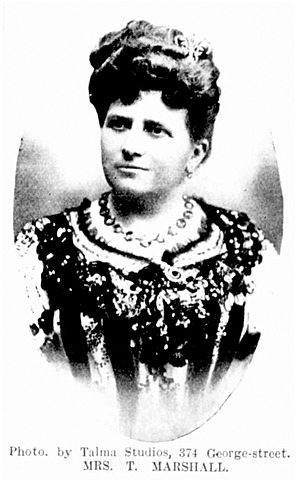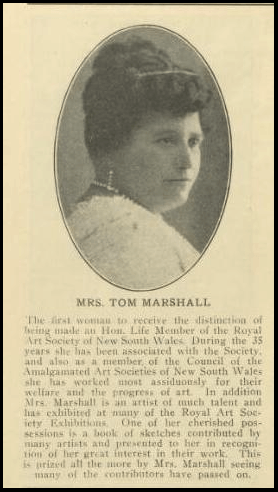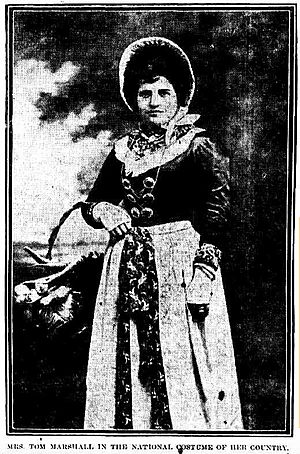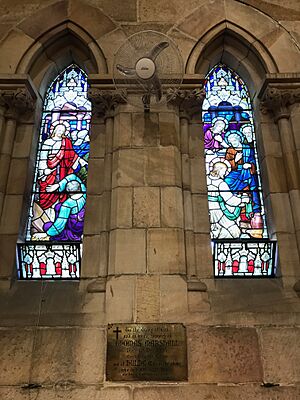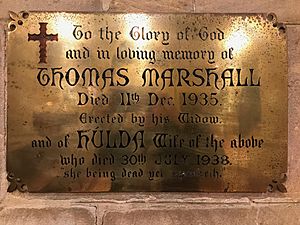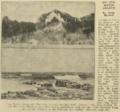Hulda Marshall facts for kids
Hulda Marshall (born Hulda Olivia Agt Jorgensen) was a talented artist, a generous supporter of the arts, and a kind helper of many causes. She was born in Denmark on September 7, 1861, and later moved to Australia. Hulda passed away in North Sydney, Australia, on July 30, 1938.
Contents
Hulda's Artistic Journey
Hulda Marshall was skilled in both watercolour and oil painting. She was a member of important art groups like the Royal Art Society and the Society of Women Painters. Hulda showed her artworks in many exhibitions from the late 1800s until 1930.
She was also a well-known supporter of the arts in Sydney. In 1929, Hulda and her husband, Thomas Marshall, were made lifelong members of the Royal Art Society. This was a big honor, shared with famous people like Dame Nellie Melba.
The Marshall Bequest: A Gift to Art
Hulda and Thomas Marshall created something special called the Marshall Bequest in 1929. This fund helps the Art Gallery of New South Wales buy new artworks. Thomas Marshall was a trustee (a kind of director) of the gallery for many years. Even today, over 90 years later, the Marshall Bequest continues to help the gallery grow its collection.
Developing Her Art Skills
Hulda said that her artistic style began at the Danish Art School in her home country. She continued to improve her oil and watercolour painting skills in Australia. She loved painting landscapes outdoors, a style known as plein air. Her home studio was filled with sketches of harbors, coasts, mountains, and oceans.
Learning from Masters
Hulda studied with important artists like Alfred Coffey. She showed her oil paintings of Tasmania at his first exhibition in Sydney in 1903. She also learned from William Lister Lister, who taught at the Strathfield Sketch Club. Her watercolour paintings were known for their soft, gentle look.
Hulda loved to travel, both within Australia and overseas. She painted the natural world wherever she went. Her artworks show places from Queensland to Tasmania, and even New Zealand, Java, Japan, and Rabaul.
Recognized Artworks
Two of her famous works are The Coaster’s Retreat (a watercolour) and Their Weary Way They Homeward Plod, Through Bracken and Through Bush (an oil painting). These were featured in a Royal Art Society publication in 1906. In 1907, Hulda became even more well-known as an artist and supporter of the arts. She helped organize the First Australian Exhibition of Women's Work. Her art was also recognized in a book called Fifty Years of Australian Art 1879-1929.
Besides showing her work, Hulda often donated her art to fundraisers. For example, she helped raise money for St Mary’s Cathedral in Sydney in 1897. Her art is now part of the collection at the Art Gallery in Denmark.
Hulda's Early Life
Hulda Olivia Agt Jorgensen was born in Denmark in 1861. She had an older sister named Nicoline Anna. When Hulda was just nine months old, she was left with her aunt and uncle to be raised. Her sister Nicoline Anna was fostered out.
When Hulda was fourteen and Nicoline Anna was sixteen, they left Denmark. They traveled all the way to New Zealand. Both sisters listed their job as 'servant' when they arrived.
Hulda later moved from New Zealand to Australia. On October 31, 1888, she married Thomas Marshall in Sydney. Thomas was a lawyer from a wealthy family. Hulda and Thomas did not have any children.
A Supporter of the Arts and Community
Hulda was a great fundraiser for the arts. She organized annual balls and gatherings to raise money. This money was used to buy artworks for the Art Gallery of New South Wales. Other artists even gave her an album of their sketches to thank her for her support.
The Marshall Bequest's Impact
In 1929, Hulda and Tom gave a property in Sydney to the Art Gallery. The money earned from this property each year goes towards buying new art. This is the Marshall Bequest, which has helped the NSW Art Gallery collect over 150 artworks.
Beyond the Art World
Hulda was also a very modern woman for her time. In 1895, she was one of the 'wheelwomen' who started the Sydney Ladies Cycling Club. It was quite revolutionary for women to ride bicycles back then!
She was also a keen yachtswoman. In 1906, she even won a yacht race, piloting her yacht 'Nanoya'.
In 1901, Hulda helped organize a Scandinavian fair in Sydney. She dressed in a traditional Danish costume and helped raise money for a cot at the Children's Hospital.
In 1921, Hulda traveled to Denmark with her husband Tom and a close friend. They went on a grand tour of Britain and Europe, visiting famous art centers.
Hulda's husband, Tom, passed away in 1935. She then asked for two beautiful stained glass panels to be made for St Thomas’ Church in North Sydney. These panels were memorials for both Tom and herself, as they had worshipped there for many years.
Hulda died at her home in North Sydney on July 30, 1938. Her ashes were scattered with Thomas Marshall’s into the ocean, as she wished.
Hulda left a considerable amount of money and property to various charities and friends. She gave gifts to the Royal Alexandra Hospital for Children, St Thomas' Church, the RSPCA (for animals), and the Far West Children’s Home, among others.
A bronze plaque beneath the stained glass panels in St Thomas’ Church remembers Hulda and Thomas. It reads: To the Glory of God/ and in loving memory of/ THOMAS MARSHALL/ Died 11th Dec 1935/ Erected by his Widow/ And of HULDA Wife of the above/ Who died 30th July 1938/ “she being dead yet speaketh”.
Images for kids


